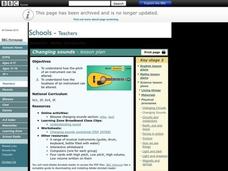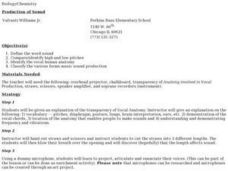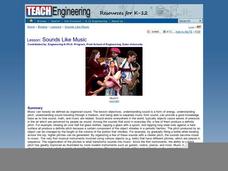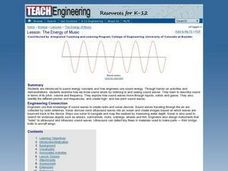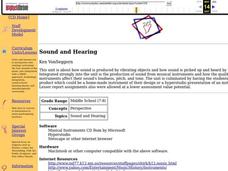Curated OER
The Vibrational Nature of Sound
Students explore the vibrational nature of sound. In this science lesson plan, students gain an understanding of sound frequency, pitch, and conduction using the string telephone, tuning fork and musical glasses experiments.
Acoustical Society of America
Musical Instruments
Mix it up and engage learners in a lesson on music and physical science. Using cups, strings, guitars, and voice, the class will experiment with sound vibration and frequency. They'll use each instrument and fill out a worksheet that...
Curated OER
Changing Sounds
Students listen to sound. In this changing sounds instructional activity, students play instruments to help them hear volume and pitch. Students use the interactive whiteboard to experiment how change can make sounds go higher or lower.
Curated OER
Sounds Like Science-Guitars
Young scholars demonstrate the relationship between a sound and its frequency. In this sound and frequency lesson, students use an old tennis racket and nylon fishing line to create a guitar. Young scholars observe the pitch and frequency.
Curated OER
Wave Speed
In this waves worksheet, students use the equation for wave speed to calculate frequency or wavelength. This worksheet has 5 problems to solve.
Curated OER
Vocal Exploration
Students explore vocal anatomy. In this biology/music lesson, students first learn vocabulary associated with the voice and body. They then use straws, microphones and recorders to differentiate between high and low pitches and...
Curated OER
The Doppler Effect Lab
In this Doppler effect instructional activity, students read information about the Doppler effect. Students answer questions as it relates to the pitch and wavelengths of a demonstration simulates what happens with the Doppler Effect.
Curated OER
Sound Observations
Students explore sound waves by conducting an experiment in class. In this sound frequency instructional activity, students utilize a tuning fork in class and identify which objects in class create different sound pitches on the fork....
Columbus City Schools
Making Waves
Learning about waves can have its ups and downs, but a demo-packed tool kit has the class "standing" for more! Learners gain experience with several different wave types, organizing observations and data, and wave terminology. The...
It's About Time
Sounds from Vibrating Air
Take note, or notes, as the case may be. A scientific music lesson is the third in a set of eight covering waves and instruments. Scholars use straws, test tubes, and water to create various wind instruments. Then, they read and answer...
LABScI
Acoustics: The Sound Lab
If the delay between a sound and its echo is less than 1/10th of a second, the human ear can’t distinguish it. Through the use of a Slinky, rubber band guitar, and straws, scholars explore where sound comes from and how it travels. Whole...
Mr. E. Science
Sound
Since light travels faster than sound, some people may appear bright until you hear them speak. The presentation covers what sound is, how fast it travels in various mediums, properties of sound, hearing, and the parts of the human ear.
Curated OER
Good Vibrations
Students demonstrate sound waves and make changes in the waves
resulting in changes in pitch. Students associate changes in pitch in various "musical instruments"with size and shape and the sound waves they produce.
Curated OER
Sizing Up Sound
Sixth graders are introduced to the concepts of sound waves and frequency. As a class, they listen to the differences between different types of instruments. To end the lesson, they practice identifying low and high pitches and playing...
Curated OER
Sounds Like Music
Students define and examine the connections between sound and music and how engineers design instruments. They listen to examples of musical instruments, view a demonstration of a tuning fork and bottles filled with varying amounts of...
Curated OER
Name That Tune: Matching Musical Tones Through Waveform Analysis
Pupils detect the waveform of musical notes to determine the code for the "safe" in this forensics simulation instructional activity. They use a microphone and tuning forks along with Vernier EasyData on their graphing calculator to...
Curated OER
From Bats to Babies: Ultrasound
Students research and analyze sound waves and how an ultrasound works to image a baby in utero. They explore various websites, complete worksheets, and write a paragraph describing a demonstration they view in the classroom.
Curated OER
Sounds Good to Me
Students determine density and hardness of wood samples based on several investigations. In this physical science and music instructional activity, students visit four centers and perform tests on wood samples to determine densities and...
Curated OER
The Energy of Music
Students discover how engineers use sound energy. They participate in hands-on activities in which they discover how we know sound exists. They identify different pitches and frequencies as well.
Curated OER
Determining Red-Shift in a Receding Star
Young scholars practice manipulating algebra formulas with more than one variable. They examine the topics of velocity, wavelength and frequency. They determine the amount of red-shift in a receding star.
Curated OER
What is Sound? How Can We Change Sound?
In this lesson, students investigate the phenomenon of sound! Students compare and contrast how sound travels through solids, liquids, and gases. They explain how length and thickness affect sound. Students know the difference between...
Curated OER
Sound and Hearing
Students discover how sound is produced by objects and picked up and heard by humans. Using musical instruments, they identify how the quality can affect the loudness, pitch and tone of the sound. They develop their own instrument or a...
Curated OER
Do You Hear What I Hear?
Students study hearing and are able to differentiate between different sound waves. For this sound wave lesson students develop a cause and effect model that shows the parts of the ear.
Curated OER
Wave Motion
Students observe and identify various waves. In this wave motion lesson, student use a Slinky, noise, people, and musical instruments to create waves and observe how each type of wave moves.




